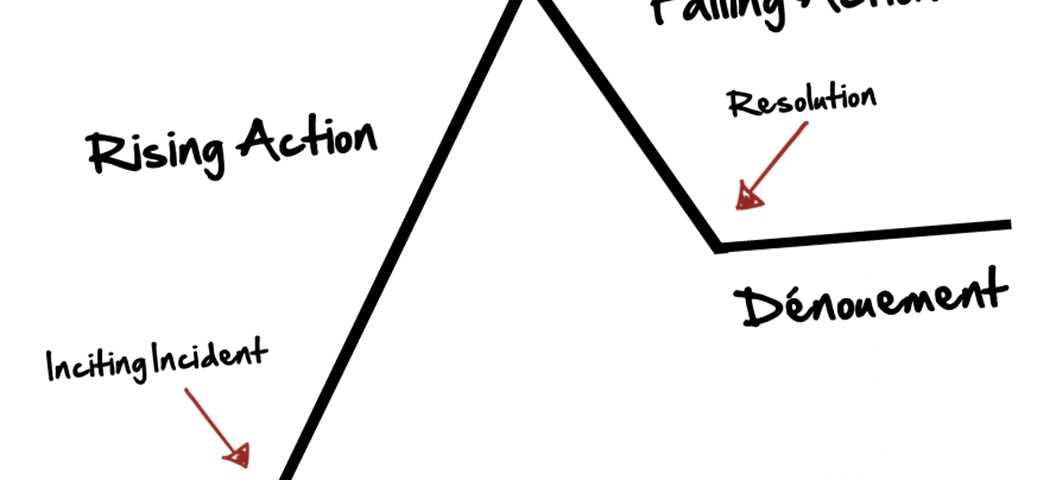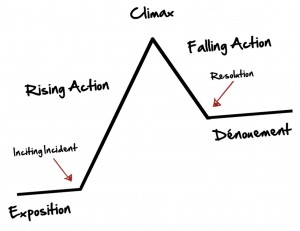Writing Stories Your Learners Will Savor
(Written by Kayleen Holt, with contributions from Monique Horvath)
“We are all made of stories. They are as fundamental to our soul, intellect, imagination, and way of life as flesh, bone, and blood are to our bodies.”
–Jack Maguire, The Power of Personal Storytelling
What can you learn about effective instructional design from bestselling authors and Broadway playwrights? Their stories are expertly crafted using the basic elements of fiction and dramatic structure, and you can use the same techniques to create engaging and meaningful scenarios for your eLearning and traditional training courses. All you need is the right recipe.
Why Use Stories in Learning Applications?
Storytelling is as old as cave drawings and an inherent part of the human experience. People don’t just enjoy stories, they crave them and devour them. Nancy Duarte says, “Stories are the most powerful delivery tool for information, more powerful and enduring than any other art form.”
Research has shown that stories are effective for instruction and help with long-term remembering. Well-crafted stories get—and keep—the learner’s attention. Stories can enhance retention and help with decision-making and problem-solving. They provide context for new information, so learners can make connections to their prior knowledge and experiences. Stories motivate and inspire, and they can make people care.
Neuroscience tells us that emotion and cognition are inextricably connected in the brain, and the right amount of emotion is a necessary part of learning. To put it simply, people remember what they feel. Stories can make that emotional connection for a learner.
In short, stories have the power to change people’s minds. And isn’t that what we, in the learning and development industry, are all about?
Recipe for a Compelling Story: The Ingredients
Although content delivery methods and media are always evolving, basic techniques for effective storytelling aren’t new. The components of a powerful story are time-tested and have been used by playwrights, novelists, and other storytellers for centuries.
In the recipe for a great story, the Elements of Fiction are the ingredients:
- Plot/Conflict—What happens in the story; Made up of action and reaction
- Setting—The time and place of the action
- Character—People or creatures who carry out the story, developed by actions, speech, appearance, etc.
- Point of View—The position from which the story is told
- Theme—The main idea of the story; What’s the point? (objectives)
- Style/Tone—How is the story told? What is the attitude toward the subject? (e.g., use of humor,formality, etc.)
- Symbolism and Imagery—Use of metaphor, allegory, etc.; sensory appeal (language use, multimedia)
A story with these ingredients doesn’t have to be long and complex, and some elements may not be as prominent as others. While some elements, such as symbolism, may not be integral to a story used in a training application, others, such as conflict, are absolutely critical. Without conflict, there’s no story.
Imagine you are taking an eLearning course—one of several you must take for compliance each year—and a scenario prompts you to remind the new hire of the next step in the company’s process for XYZ. What’s your motivation level? About zero, if you’re like most of us. If there’s no conflict, there’s no story—and no motivation.
If you want your learner to care, stir up some trouble! Using the same example, let’s say the company will lose an important client if the process isn’t done exactly right. Then the boss will be upset with you because you were in charge of training the newbie. Now you have conflict—suffering, even! As a result, the learner is more likely to care about the story and, by extension, the material.
When you’re writing a training story, whether it is a fictional scenario or a case study based on real-life events, consider questions like these:
- What’s a common critical error made by the target audience on the job?
- What could happen if they get it wrong?
- What are the rewards for getting it right?
Build your stories around those answers, and you’ll ensure that they are realistic, relevant, and meaningful.
Recipe for a Compelling Story: The Steps
How do great writers mix up the ingredients, or the elements, of fiction just right? Every story has a beginning, a middle, and an end, and the events that make up these parts build on each other in a repeating process of action and reaction. A well-known and widely used plot structure to represent this process is the Dramatic Arc.
You probably learned this structure in a high school English class. In case it’s been a while, here’s a quick review:
- The Exposition introduces the main characters and sets the scene. Some exposition can continue throughout the story, as more information is discovered.
- The Inciting Incident is the event that introduces the conflict.
- During Rising Action, the conflict builds, generally through a series of events. In a training scenario, a learner may be given information and make choices along the way to build tension with each consequence.
- As shown in the diagram, the Climax is the point of highest tension in the story. It is the turning point, when things change—for better or for worse.
- During Falling Action, the loose ends of the story get tied up, and there is often a key change in the main character.
- Finally, the outcome of the story is shown in the Resolution/Denouement. In training scenarios, this is usually represented by feedback for the learner, which may also include the falling action that leads to the resolution.
These stages can be employed in very short scenarios as well as longer, more developed stories. If you’d prefer a simpler version of a plot structure for decision-making scenario development, consider Tom Kuhlman’s 3 C’s.
Serving Up the Story
The story can be presented in a variety of ways, including text, audio, video, animation, photos, illustrations, comics, and other media.
A story is much more effective when supported by compelling visuals. “Supported by” are key words here. Don’t go throwing just any picture or other medium into your course willy-nilly for spark and sizzle; make sure it is relevant to the story and the content you are teaching.
Audio and visual components that support the training message produce better results than training with incongruent elements or training presented through only one medium. In fact, the use of “seductive” text and illustrations—those that are interesting but unimportant—has been shown to cause a 76% reduction in recall of main points. The last thing you want to do is distract the learner from the message you intend to convey.
As an example of a story that follows the recipe quite well, while using media consistent with the training message, we like this course from the World Warfighter Culture and Language Training Program. This engaging story presents consequences that build the story based on learner choices.
Get Cooking!
Like Grandma’s secret recipe for pull-apart rolls, the techniques we’ve presented here have been around a long time. However, they’re no family secret. Anyone can put together a compelling story—it’s just a matter of understanding how to mix the ingredients.
“Inside each of us is a natural-born storyteller, waiting to be released.”
—Robin Moore, Awakening the Hidden Storyteller
Think about training stories and scenarios you have developed, or those in courses you have taken as a learner. Did they follow the recipe presented here? We’d love to hear from you.
Hungry for More?
Download this list of resources (Storytelling Resources_Final) to learn more about the art of storytelling, and view more examples of creative courseware in our portfolio.











